Anti-lock Braking System (ABS) warning light (if equipped)
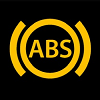
When the ignition switch is in the “ON” position, the Anti-lock Braking System (ABS) warning light illuminates and then turns off. This indicates the ABS is operational. If the ABS warning light illuminates while the engine is running, or while driving, it may indicate the ABS is not functioning properly.
Have the system checked by a NISSAN dealer promptly. If an ABS malfunction occurs, the anti-lock function is turned off. The brake system then operates normally, but without anti-lock assistance.
Brake warning light
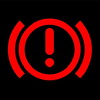
The brake warning light indicates the parking brake system operation, a low brake fluid level of the brake system and an Anti-lock Braking System (ABS) malfunction.
Parking brake warning indicator: When the ignition switch is placed in the “ON” position, the brake warning light illuminates. When the engine is started and the parking brake is released, the brake warning light turns off.
If the parking brake is not fully released, the brake warning light remains on. Be sure that the brake warning light has turned off before driving.
Low brake fluid warning indicator: If the brake warning light illuminates while the engine is running, or while driving, and the parking brake is released, it may indicate the brake fluid level is low.
When the brake warning light illuminates while driving, stop the vehicle safely as soon as possible. Stop the engine and check the brake fluid level. If the brake fluid level is at the minimum mark, add brake fluid as necessary.
If the brake fluid level is sufficient, have the brake system checked by a NISSAN dealer promptly.
Anti-lock Braking System (ABS) warning indicator (if equipped): When the parking brake is released and the brake fluid level is sufficient, if both the brake warning light and the Anti-lock Braking System (ABS) warning light illuminate, it may indicate the ABS is not functioning properly. Have the brake system checked, and if necessary repaired, by a NISSAN dealer promptly.
Charge warning light
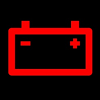 When the ignition switch is in the “ON” position, the charge warning light illuminates. After starting the engine, the charge warning light turns off. This indicates the charging system is operational.
When the ignition switch is in the “ON” position, the charge warning light illuminates. After starting the engine, the charge warning light turns off. This indicates the charging system is operational. If the charge warning light illuminates while the engine is running, or while driving, it may indicate the charging system is not functioning properly and may need servicing.
When the charge warning light illuminates while driving, stop the vehicle safely as soon as possible. Stop the engine and check the alternator belt. If the alternator belt is loose, broken or missing, the charging system needs repair. If the alternator belt appears to be functioning correctly but the charge warning light remains illuminated, have the charging system checked by a NISSAN dealer promptly.
Door open warning light
When the ignition switch is in the “ON” position, the door open warning light illuminates if any of the doors are open or not closed securely.
Electric power steering warning light When the ignition switch is in the “ON” position, the electric power steering warning light illuminates. After starting the engine, the electric power steering warning light turns off. This indicates the electric power steering system is operational.
If the electric power steering warning light illuminates while the engine is running, it may indicate the electric power steering system is not functioning properly and may need servicing. Have the electric power steering system checked by a NISSAN dealer.
When the electric power steering warning light illuminates with the engine running, the power assist to the steering will cease operation but you will still have control of the vehicle. At this time, greater steering efforts are required to operate the steering wheel, especially in sharp turns and at low speeds.
Engine oil pressure warning light

When the ignition switch is in the “ON” position, the engine oil pressure warning light illuminates. After starting the engine, the engine oil pressure warning light turns off. This indicates that the oil pressure sensors in the engine are operational.
If the engine oil pressure warning light illuminates while the engine is running, it may indicate that the engine oil pressure is low. Stop the vehicle safely as soon as possible. Stop the engine immediately and call a NISSAN dealer.
Running the engine with the engine oil pressure warning light illuminated could cause serious damage to the engine. The engine oil pressure warning light is not designed to indicate a low oil level. The oil level should be checked using the dipstick.
Intelligent Key system warning light (if equipped)
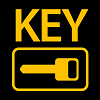
After the ignition switch is placed in the “ON” position, this light comes on for about 2 seconds and then turns off. This light illuminates or blinks as follows: The light blinks in yellow when the door is closed with the Intelligent Key left outside the vehicle and the ignition switch in the “ACC” or “ON” position. Make sure that the Intelligent Key is inside the vehicle.
The light blinks in green when the Intelligent Key battery is running out of power. Replace the battery with a new one. The light illuminates in yellow when it warns of a malfunction with the electrical steering lock system or the Intelligent Key system.
If the warning light illuminates in yellow while the engine is stopped, it may be impossible to free the steering lock or to start the engine. If the light comes on while the engine is running, you can drive the vehicle. However in these cases, contact a NISSAN dealer for repair as soon as possible.
Low fuel warning light
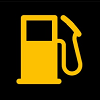
The low fuel warning light illuminates when the fuel level in the tank is getting low. Refuel as soon as it is convenient, preferably before the fuel gauge reaches 0 (empty). There will be a small reserve of fuel remaining in the tank when the fuel gauge reaches 0 (empty).
Low tire pressure warning light (if equipped)

When the ignition switch is in the “ON” position, the low tire pressure warning light illuminates and then turns off. This indicates that the low tire pressure warning system is operational. This light illuminates if there is low tire pressure or a tire pressure warning system malfunction. The Tire Pressure Monitoring System (TPMS) monitors the tire pressure of all tires except the spare.
Low tire pressure warning: If the vehicle is being driven with low tire pressure, the low tire pressure warning light will illuminate. When the low tire pressure warning light illuminates, you should stop and adjust the tire pressure to the recommended COLD tire pressure shown on the tire placard.
The low tire pressure warning light does not automatically turn off when the tire pressure is adjusted. After the tire is inflated to the recommended pressure, the vehicle must be driven at speeds above 25 km/h (16 MPH) to activate the TPMS and turn off the low tire pressure warning light. Use a tire pressure gauge to check the tire pressure.
TPMS malfunction: If the TPMS is not functioning properly, the low tire pressure warning light will flash for approximately 1 minute when the ignition switch is placed in the “ON” position. The light will remain on after the 1 minute. Have the system checked by a NISSAN dealer.
If the light does not illuminate with the ignition switch placed in the “ON” position, have the vehicle checked by a NISSAN dealer as soon as possible. If the light illuminates while driving, avoid sudden steering maneuvers or abrupt braking, reduce vehicle speed, pull off the road to a safe location and stop the vehicle as soon as possible. Driving with under-inflated tires may permanently damage the tires and increase the likelihood of tire failure. Serious vehicle damage could occur and may lead to an accident and could result in serious personal injury.
Check the tire pressure for all four tires. Adjust the tire pressure to the recommended COLD tire pressure shown on the tire placard to turn the low tire pressure warning light off. If the light still illuminates while driving after adjusting the tire pressure, a tire may be flat or the TPMS may be malfunctioning. If you have a flat tire, replace it with a spare tire as soon as possible. If no tire is flat and all tires are properly inflated, have the vehicle checked by a NISSAN dealer.
Since the spare tire is not equipped with the TPMS, when a spare tire is mounted or a wheel is replaced, the TPMS will not function and the low tire pressure warning light will flash for approximately 1 minute. The light will remain on after the 1 minute. Contact your NISSAN dealer as soon as possible for tire replacement and/or system resetting.
Replacing tires with those not originally specified by NISSAN could affect the proper operation of the TPMS. The TPMS is not a substitute for the regular tire pressure check. Be sure to check the tire pressure regularly. If the vehicle is being driven at speeds of less than 25 km/h (16 MPH), the TPMS may not operate correctly. Be sure to install the specified size of tires to all four wheels correctly.
Low washer fluid warning light (if equipped) This light comes on when the washer tank fluid is at a low level. Add washer fluid as necessary.
position selecting warning light (if equipped)
The warning light blinks in red when the ignition switch is pushed to stop the engine with the shift lever in any position except the “P” (Park) position. If this warning appears, move the shift lever to the “P” (Park) position or push the ignition switch to the “ON” position. An inside warning chime will also sound.
Seat belt warning light

Type A: When the ignition switch is in the “ON” position, the seat belt warning light illuminates. The light will continue to illuminate until the front seat belts are fastened. When the vehicle speed exceeds 15 km/h (10 MPH), the light will blink and the chime will sound unless the front seat belts are securely fastened. The chime will continue to sound for about 90 seconds until the seat belt is fastened.
Type B: When the ignition switch is in the “ON” position, the seat belt warning light illuminates. The light will continue to illuminate until the driver’s seat belt is fastened. When the vehicle speed exceeds 15 km/h (10 MPH), the light will blink and the chime will sound unless the driver’s seat belt is securely fastened. The chime will continue to sound for about 90 seconds until the seat belt is fastened.
Type C: When the ignition switch is in the “ON” position, the seat belt warning light illuminates. The light will continue to illuminate until the driver’s seat belt is fastened.
Speed [120 km/h (75 MPH)] warning light (if equipped) This light blinks when the vehicle speed goes over approximately 120 km/h (75 MPH). Be sure to observe the speed limit in the area where you are driving.
Supplemental Restraint System (SRS) air bag warning light
 When the ignition switch is in the “ON” position, the Supplemental Restraint System (SRS) air bag warning light illuminates for about 7 seconds and then turns off. This indicates the SRS air bag system is operational. If any of the following conditions occur, the SRS air bag system and pre-tensioner seat belt need servicing. Have the system checked, and if necessary repaired, by a NISSAN dealer promptly.
When the ignition switch is in the “ON” position, the Supplemental Restraint System (SRS) air bag warning light illuminates for about 7 seconds and then turns off. This indicates the SRS air bag system is operational. If any of the following conditions occur, the SRS air bag system and pre-tensioner seat belt need servicing. Have the system checked, and if necessary repaired, by a NISSAN dealer promptly. The SRS air bag warning light remains illuminated after about 7 seconds. The SRS air bag warning light flashes intermittently. The SRS air bag warning light does not come on at all. Unless checked and repaired, the SRS air bag system and/or pre-tensioner seat belt may not function properly.
Vehicle Dynamic Control (VDC) warning light (if equipped)
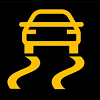 When the ignition switch is in the “ON” position, the Vehicle Dynamic Control (VDC) warning light illuminates and then turns off. This indicates the VDC system is operational.
When the ignition switch is in the “ON” position, the Vehicle Dynamic Control (VDC) warning light illuminates and then turns off. This indicates the VDC system is operational. The warning light blinks when the VDC system is operating. When the warning light blinks while driving, the driving condition is slippery and the vehicle’s traction limit is about to be exceeded. If the warning light illuminates when the ignition switch is placed in the “ON” position, it may indicate that the VDC system is not functioning properly and may need servicing.
Have the system checked, and if necessary repaired, by a NISSAN dealer promptly. If a malfunction occurs in the system, the VDC system function will be cancelled but the vehicle is still driveable.
